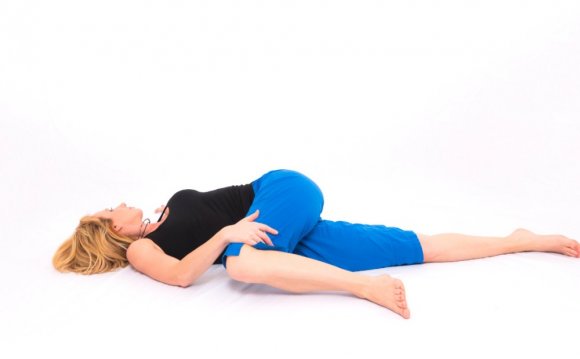
Pleas says there are three key steps to restorative yoga: Relax your body and muscles; slow, lengthen and deepen your breath; and calm your mind. But don’t worry, that doesn’t mean turn your brain off completely (or any of these 10 hilarious stages of trying to meditate for the first time!). “A calm mind is not a mind that’s no longer thinking, ” Pleas says. “Because we’re human, we’re wired to constantly be having thoughts all the time. But it’s a mind that can observe what is moving through it, the thoughts moving through it, or strong emotions and sensations that are happening in your body.”
By laying in these restorative poses, you bring your attention to the areas of your body that are holding tension, whether it’s between your shoulders, around your hips, or in your belly. Once you realize where you hold tension, instead of trying to fix or change it, simply bring your breath to that area.
Here’s how it works: Warm up with some Cat and Cow Poses or breathing exercises first. Then try these four moves, recommended by Pleas, and start to feel a little bit more zen. Do one pose or a series of poses before bed three to five times a week; hold each pose for five to 20 minutes (yes, seriously!).
Legs Up The Wall
Lie down on your back and put your legs up against the wall. If that’s too much strain on your hamstrings, bend your knees and put your legs over a chair or bed.
“By bringing your legs up, you’re bringing your blood flow down into your belly and into your digestive organs, ” Pleas says. “We spend all day long upright, so you’re reversing the lymphatic drainage and bringing lymphatic fluid into your abdominal area where all of your organs are.”
Revolved Bolster Twist
Sit sideways at the base of the bolster, bending both knees at a 90-degree angle while keeping the upper thigh and the lower thigh back. Twist your torso away from your front thigh and face.
“If you think of a way that mother animals care for their kids, they put them belly down on the mother’s chest. Just having weight on your chest or on your belly is a really grounding, safe feeling, ” Pleas says.
Supported Corpse Pose
Lie down on your back with pillows or blocks under your knees so that they are slightly elevated.
Pleas says: “The hip flexors are the first muscles to respond to any kind of stress, physical or psychological. As part of our fight or flight response, those muscles want to mobilize us to get us ready to go. If you support your knees a little, and then do deep breathing you can more successfully get your hip flexors to relax.”
Reclining Bound Angle Pose
Lie on your back with your knees and feet together. Let you knees drop out to one side and place a yoga block or bolster underneath them. Put a heavy blanket over your belly.









